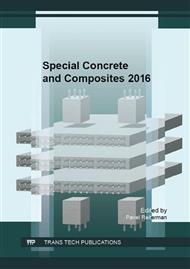[1]
M. Guadalupe Sierra-Beltran, H. M. Jonkers, E. Schlangen. Characterization of sustainable bio-based mortar for concrete repair. Construction and Building Materials 67: 344-352, (2014).
DOI: 10.1016/j.conbuildmat.2014.01.012
Google Scholar
[2]
B.A. Tayeh, B.H. Abu Bakar, M.A. Megat Johari, Y.L. Voo. Mechanical and permeability propertias of the interface between normal concrete substrate and ultra high performance concrete overlay, Construction and Building Materials 36: 538-548, (2012).
DOI: 10.1016/j.conbuildmat.2012.06.013
Google Scholar
[3]
T. Phoo-ngernkham, V. Sata, S. Hanjitsuwan, C. Ridtirud, S. Hatanaka, P. Chindaprasirt. High calcium fly ash geopolymer mortar containing Portland cement for use as repair material. Construction and Building Materials 98: 482-488, (2015).
DOI: 10.1016/j.conbuildmat.2015.08.139
Google Scholar
[4]
J. Qian, C. You, Q. Wang, X. Jia. A method for assessing bond performance of cement-based repair materials. Construction and Building Materials 68: 307-313, (2014).
DOI: 10.1016/j.conbuildmat.2014.06.048
Google Scholar
[5]
J.V. Brien, K.C. Mahboub. Influence of polymer type on adhesion performance of a blended cement mortar. International Journal of Adhesion & Adhesives 43: 7-13, (2013).
DOI: 10.1016/j.ijadhadh.2013.01.007
Google Scholar
[6]
S.E. Chidiac, S.N. Mihaljevic. Performance of dry cast concrete blocks containing waste glass powder or polyethylene aggregates. Cement & Concrete Composites 33: 855-863, (2011).
DOI: 10.1016/j.cemconcomp.2011.05.004
Google Scholar
[7]
L. Agavriloaie, S. Oprea, M. Barbuta, F. Luca. Characterization of polymer concrete with epoxy polyurethane acryl matrix. Construction and Building Materials 37: 190-196, (2012).
DOI: 10.1016/j.conbuildmat.2012.07.037
Google Scholar
[8]
J. Justs, M. Wyrzykowski, D. Bajare, P. Lura. Internal curing by superabsorbent polymers in ultra-high performance concrete. Cement and Concrete Research 76: 82-90, (2015).
DOI: 10.1016/j.cemconres.2015.05.005
Google Scholar
[9]
H. Huang, B. Lui, K. Xi, T. Wu. Interfacial tensile bond behavior of permeable polymer mortar to concrete, Construction and Building Materials 121: 210-221, (2016).
DOI: 10.1016/j.conbuildmat.2016.05.149
Google Scholar
[10]
J.A. Thamboo, M. Dhanasekar. Characterisation of thin layer polymer cement mortared concrete masonry bond. Construction and Building Materials 82: 71-80, (2015).
DOI: 10.1016/j.conbuildmat.2014.12.098
Google Scholar
[11]
A.D. Espeche, J. Leon. Estimation of bond strength envelopes for old-to-new concrete interfaces based on a cylinder splitting test. Construction and Building Materials 25: 1222-1235, (2011).
DOI: 10.1016/j.conbuildmat.2010.09.032
Google Scholar
[12]
A. Kanellopoulos, F.A. Farhat, D. Nicolaides, B.L. Karihaloo. Mechanical and fracture properties of cement-based bi-materials after thermal cycling. Cement and Concrete Research 39: 1087-1094, (2009).
DOI: 10.1016/j.cemconres.2009.07.008
Google Scholar
[13]
A. Pallegedara, M. Petřik, P Štemberk. Design of temperature controlled seasonal weather emulating chamber for rapid testing of concrete samples: Peltier model phase. Proceedings of the 19th International Conference Mechanika, 2014, pp.182-186.
Google Scholar
[14]
R.D. Cook, D.S. Malkus, M.E. Plesha, R.J. Witt. Concepts and Application of finite Element Analysis. 4th ed. University of Wisconsin, Madison, 2001, pp.454-459.
Google Scholar
[15]
H.C. Huang, A.S. Usmani. Finite Element Analysis for Heat Transfer. Theory and software. Springer-Verlag London Limited, 1994, pp.14-15.
Google Scholar
[16]
G.R. Liu, S.S. Queg. The Finite Element Method: A Practical Course. Elsevier Science Ltd, 2003, pp.17-19.
Google Scholar
[17]
S.S. Rao. The Finite Element Method in Engineering. 4th ed. Elsevier Science & Technology Books, 2004, pp.399-402.
Google Scholar


